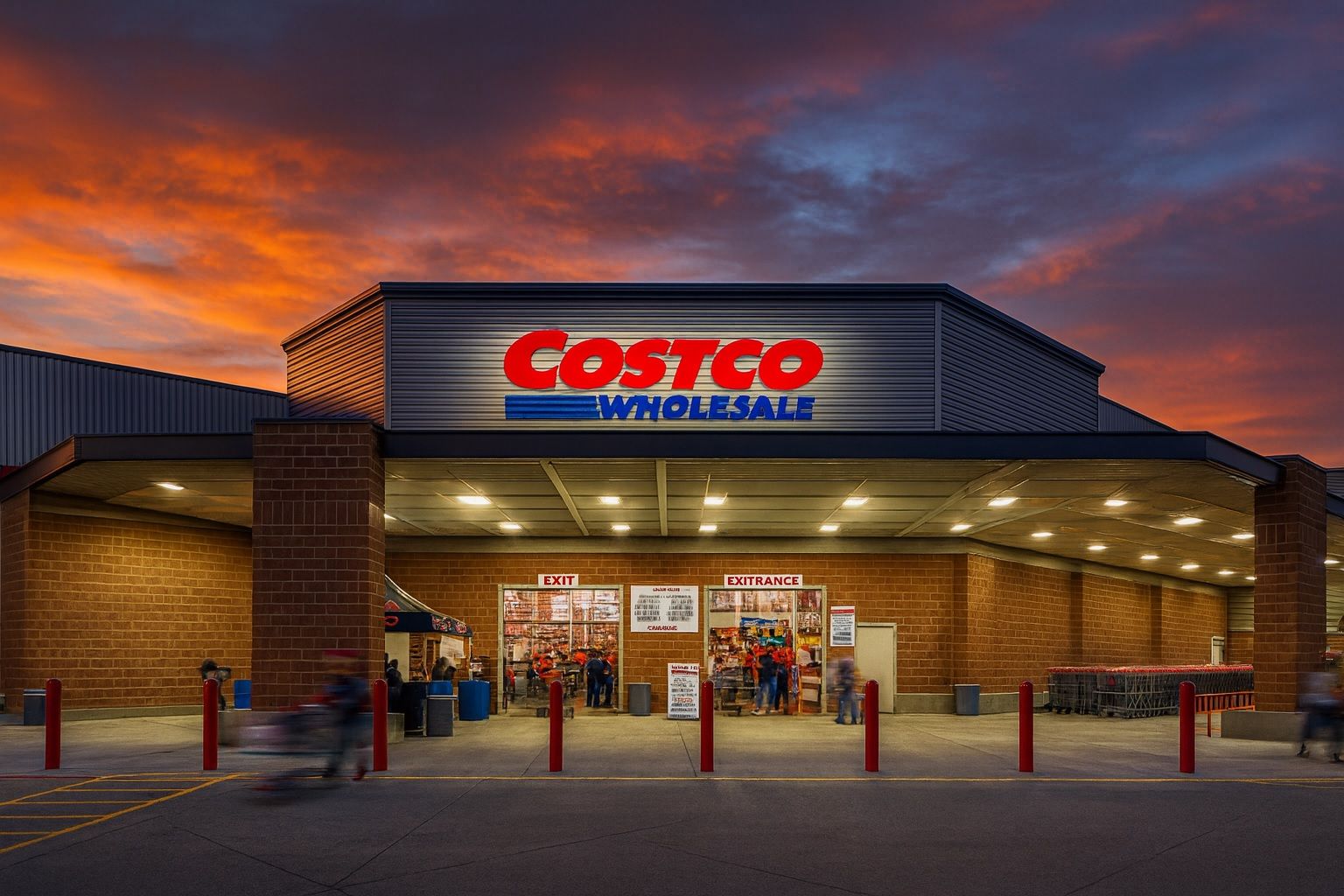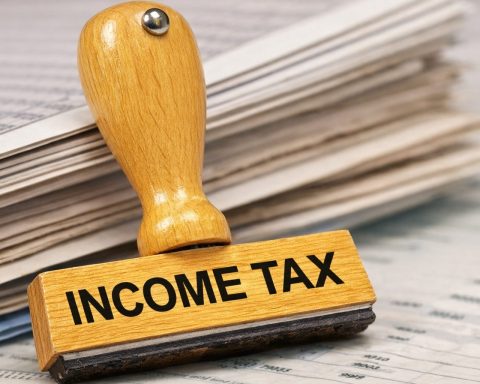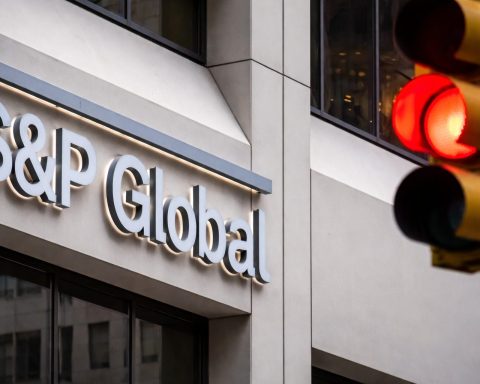- Current Price (Oct 23, 2025): Costco Wholesale (NASDAQ: COST) stock is trading around $938.7 mid-session, down ~0.6% from yesterday’s close of $944.68 [1]. Shares are roughly flat year-to-date (about +3%) after a volatile year, having hit an all-time high near $1,078 earlier in 2025 [2].
- Recent Performance: Costco’s stock climbed back into the mid-$940s this week after a dip to the $920s last week [3]. The S&P 500 is hovering near record levels, and Costco has outpaced many retail peers – it’s modestly up ~3% YTD, while rivals like Walmart and Target have lagged [4].
- Latest Earnings Beat: Fiscal Q4 2025 (ended Aug. 31) results topped forecasts. Net sales rose ~8% to $84.4 billion, net income hit $2.61 billion (EPS $5.87, +11% YoY) [5], and same-store sales (ex-gas) climbed 6.4% (slightly above analyst estimates [6]). High-margin membership fee revenue jumped 14% to $1.72 billion [7], boosting profits.
- Growth & Strategy: Costco is aggressively expanding its warehouse footprint. It plans 35 new warehouses in FY2026 (30 net new stores) [8] after opening 27 last year. Total locations now top 914 warehouses (629 in the U.S.) [9]. In late October, Costco is opening new clubs in Michigan, Pennsylvania, South Carolina and Ontario as it pushes into fresh markets [10]. Executives see “significant opportunities for expansion, both domestically and internationally,” says CEO Ron Vachris [11].
- Analyst Outlook: Wall Street remains broadly bullish on COST. No major analyst rates it a Sell – most are Buys – and the consensus 12-month price target is around $1,050+ (≈10–15% above current levels) [12]. Goldman Sachs recently raised its target to $1,133 and Morgan Stanley to $1,225, citing Costco’s solid execution [13]. However, some warn the stock’s rich valuation (~50× trailing earnings) leaves little room for error [14].
COST Stock Slips as Market Pauses Near Highs
Thursday, Oct. 23, 2025 – Costco’s stock is edging lower today after a steady three-day climb. By midday, COST traded around $939, off about 0.6% from Wednesday’s close [15]. The slight pullback comes as broader U.S. markets take a breather near record highs – the Dow Jones and S&P 500 hit fresh peaks this week, though the Nasdaq lagged on some mixed tech earnings [16] [17]. Costco’s modest dip follows a +0.8% gain yesterday and reflects a bit of profit-taking after the stock’s recent rebound.
Last week, Costco shares briefly slid to ~$924 (Oct. 16) amid a retail sector slump [18]. That day saw many retailers sink as rising bond yields and jitters about holiday spending hit the group. Costco fell ~3.4% intraday on Oct. 16 [19] – far less than its peak-to-trough drop earlier this year, but notable given Costco’s usual stability. Rival big-box chains were also down: Walmart (WMT) and Target (TGT) dropped ~2–3% on Oct. 16 [20]. Despite that pullback, Costco has fared better than most: it remains up about 3% in 2025, essentially flat year-to-date with dividends included [21]. In contrast, many retail stocks are flat or negative on the year [22]. Costco’s ability to hold gains – even as its shares retreated from a record ~$1,078 high reached earlier in 2025 [23] – underscores its defensive appeal. “Costco is better at everything – from pricing to customer satisfaction – than its brick-and-mortar rivals,” says retail consultant Burt Flickinger, highlighting Costco’s competitive moat [24].
This week, bullish momentum returned to Costco’s stock. Strong corporate earnings in other sectors and hopes of Federal Reserve rate cuts by late 2025 improved market sentiment [25]. Costco’s stock rose from the high-$920s last Friday to the mid-$940s by Wednesday’s close. At current levels around $939, Costco is roughly +5% above its October lows and +10% higher than a year ago [26] [27]. The stock’s resilience reflects investors’ confidence in Costco’s steady sales and membership-driven model, even as economic cross-currents make other retailers wobble.
Earnings Beat Expectations in Q4 FY2025
Costco’s latest earnings report gave investors plenty of reason for optimism. In late September, the company announced strong fiscal Q4 2025 results (for the quarter ended Aug. 31) that topped Wall Street forecasts on both sales and profits. Revenue jumped ~8% year-over-year to $86.16 billion [28], slightly above analyst consensus of about $86.06 billion [29]. Net income climbed 11% to $2.61 billion, and earnings per share hit $5.87 (up from $5.29 a year ago) [30] – beating the $5.80 EPS expected by analysts [31]. Costco notched these gains despite some macro headwinds, thanks to robust demand for groceries and household essentials.
Critically, membership-fee income surged 14% to $1.72 billion in the quarter [32]. This high-margin revenue stream (fueled in part by a fee hike last year) provided a big profit boost. Executives noted Costco has been reinvesting part of that fee increase into lower prices for members, which drives loyalty and sales [33]. It’s essentially a virtuous cycle. “Costco’s approach is a ‘win-win’ for both members and shareholders,’” observes CFRA analyst Arun Sundaram, who says the chain’s strategy of plowing fee gains back into better deals bolsters customer loyalty while still lifting margins [34]. That formula – giving shoppers more value for their membership – appears to be paying off handsomely.
Costco’s same-store sales (excluding fuel) rose about +6.4% last quarter [35], slightly above expectations. Shoppers kept flocking to Costco for staple goods, even as U.S. consumers grew more budget-conscious. E-commerce sales were a bright spot too (up ~13.6% YoY) [36], though management did flag some softness in discretionary departments like electronics and jewelry. On the earnings call, Costco noted a “slight pullback” in higher-priced discretionary purchases as inflation and economic uncertainty made shoppers cautious [37]. That cautious commentary tempered the otherwise very strong quarter – and Costco’s stock dipped ~3% after-hours when results came out [38].
However, the post-earnings jitters proved short-lived. By early October, fresh sales data eased investors’ concerns. Costco reported September net sales of $26.58 billion, up ~8% year-on-year, with comparable-store sales roughly +5–6% [39]. This strong September performance showed that consumer demand at Costco remained resilient into the fall. In response, COST shares jumped back into the low-$920s in early trading on Oct. 9 [40]. Analysts and investors cheered the solid sales as evidence that Costco can keep growing even as post-summer spending cools. “Costco’s strategy – from local sourcing to a limited, value-focused assortment – positions them well for a strong holiday shopping season, even with consumers tightening belts,” notes retail advisor Greg Zakowicz [41]. In other words, Costco’s no-frills, bargain-centric approach is exactly what many shoppers want when money gets tight.
Expansion Plans Fuel Long-Term Growth
Costco isn’t just relying on existing stores to drive growth – it’s rapidly expanding its warehouse empire. The company opened 27 new warehouses globally in the past fiscal year and has even bigger plans for the year ahead [42]. In FY2026 (which runs through next August), Costco expects to add 35 new warehouses net of relocations [43]. That includes entering new markets and filling gaps in existing ones. As of this month, Costco operates 914 warehouses worldwide, with 592 in the U.S. and the rest across Canada, Asia, Europe and Latin America [44].
Several new Costco locations are debuting this fall. Later in October, the retailer will cut the ribbon on new stores in Fruitport, Michigan; Mechanicsburg, Pennsylvania; and Indian Land, South Carolina, as well as a business center in Mississauga, Ontario [45]. These openings continue Costco’s march into both middle America and international locales. CEO Ron Vachris recently reaffirmed that Costco sees “significant opportunities for expansion, both domestically and internationally” [46]. Even in the U.S., many Costco outlets are in older locations; CFO Gary Millerchip highlighted that replacing or upgrading 20+ year-old warehouses “presents an opportunity for us to refresh and maintain best-in-class service” as the chain grows [47].
Beyond new stores, Costco is also investing in e-commerce, supply chain and services to add value for members. It continues to build out its online ordering and delivery options, though in-warehouse sales remain its core strength. Notably, Costco’s famed “treasure-hunt” merchandising – limited SKU counts, rotating deals, and surprise in-store finds – helps drive frequent visits and impulse buys. This model, supported by a $60+ annual membership fee, has created a loyal customer base that competitors struggle to match. According to industry data, foot traffic at warehouse clubs (Costco, Sam’s Club, BJ’s) has been rising ~3–6% in recent months, even as many department stores and supermarkets see declines [48]. That suggests Costco is poaching shoppers from other retailers, thanks to its value proposition.
Analysts: Upside Remains, But Valuation “Priced for Perfection”
Wall Street analysts generally agree that Costco’s strengths justify a premium, but opinions diverge on how much higher the stock can go. Around 30 analysts cover Costco and not a single one rates it “Sell” [49]. The vast majority have Buy or Overweight ratings, with a few Holds. The average 12-month price target hovers around $1,060–1,070 per share [50] – implying roughly +12–15% upside from current levels. In short, the Street still sees Costco stock climbing into the ~$1,050s over the next year, following its early-2025 peak above $1,000.
Some prominent analysts are even more bullish. For instance, Goldman Sachs recently boosted its price target to $1,133 after Costco’s strong Q3 results, citing the company’s resilient sales and membership model [51]. Morgan Stanley has an even higher target of $1,225 [52], reflecting confidence that Costco can keep up steady growth. Other firms like BTIG have issued similarly optimistic targets in the $1,100+ range [53]. These bulls argue that Costco’s consistent mid-single-digit sales growth, double-digit earnings growth, and expansion runway (both in new stores and services) warrant its rich valuation [54]. They point out that Costco’s membership renewal rates are around 90%, and its ability to increase fees over time (as it did in 2022) provides a unique profit lever most retailers lack.
That said, valuation is the sticking point for some observers. Costco shares trade around 50× trailing earnings (≈30× forward earnings) [55] – a much higher P/E than retail peers like Walmart (~34×) or Target (~11×) [56]. In other words, Costco is priced for robust growth and near-flawless execution. Skeptics caution that COST is “priced for perfection,” meaning any stumble in sales or profits could spur a sharp correction [57]. “Investors should be aware that Costco’s future gains hinge on sustaining that growth in a slowing retail environment,” one TS2.tech analysis noted [58]. Even some bullish analysts have trimmed their expectations slightly: for example, Evercore ISI recently cut its target from $1,060 to $1,025 (maintaining an Outperform rating), and Mizuho lowered its target from $975 to $950 with a Neutral stance [59] [60]. These moves reflect caution that Costco’s stock might not have huge upside left unless it delivers consistently strong numbers.
Looking ahead, Costco’s holiday quarter will be pivotal. The current quarter (Q1 FY2026 covering the holidays) is arguably the most important sales period of the year. Analysts say a robust holiday season could push COST shares back above $1,000, while a disappointment might knock the stock down into the $800s [61] [62]. Bloomberg’s retail columnist Jonathan Lansman notes that even in an economic slowdown, “Costco is one of the few retailers that does well,” given its focus on essential goods [63]. But if consumer spending wavers significantly, even Costco would feel the effects. For now, virtually no one on Wall Street is betting against Costco – short interest is minimal [64] – and long-term investors often treat dips as buying opportunities. As retail expert Burt Flickinger put it, Costco’s consistent excellence in price, quality and customer satisfaction gives it a wide moat that competitors struggle to cross [65].
U.S. Retail & Economic Outlook Heading Into Holidays
Broader retail sector trends will set the backdrop for Costco’s next moves. Industry forecasts suggest the upcoming holiday shopping season could be the slowest since 2020. Deloitte projects U.S. holiday retail sales to grow just ~2.9–3.4% this year – a tepid pace compared to the post-pandemic boom years [66]. Persistent inflation and high borrowing costs are expected to curb consumers’ holiday spending appetites. Indeed, American shoppers have become more value-conscious, focusing on necessities and seeking out discounts as their budgets tighten.
This environment plays to Costco’s strengths. In a world of 5%+ grocery inflation and stretched wallets, Costco’s bulk bargains are especially attractive. Recent data show that foot traffic is rising at warehouse clubs like Costco and Sam’s Club, even as many traditional retailers see declines [67]. Shoppers appear to be consolidating trips and flocking to stores where they perceive better value per dollar – a trend that bodes well for Costco’s member base growth. Unemployment remains low and wage growth, while cooling, is still positive, which supports baseline consumer spending on essentials. If gasoline and food prices stabilize, it could free up some disposable income for Costco’s typical year-end “treasure hunt” items (from big-screen TVs to jewelry) that have seen softer demand lately.
Another macro factor is interest rates. After a rapid series of rate hikes, the Federal Reserve has paused increases, and many economists predict rate cuts by mid-to-late 2025 [68] [69]. Easing interest rates could improve consumer sentiment and lower credit card rates, helping retail sales. Lower rates also tend to boost equity valuations, which might further support Costco’s premium stock price. However, uncertainty lingers around potential U.S. government shutdowns and global conflicts, which could dent consumer confidence.
Bottom line: Costco enters the 2025 holiday season as a retail standout – posting strong sales gains, expanding its reach, and maintaining an exceptionally loyal customer base. The stock has been a steady performer in a turbulent market, and analysts largely remain optimistic that it can grind higher. “Most analysts see upside for COST, albeit from a high base,” one recent TS2.tech report summarized [70]. The consensus is that Costco’s formula of membership growth, international expansion, and unbeatable value will continue to pay off. Still, with the stock near $940 and trading at lofty multiples, investors will be watching upcoming sales reports and economic indicators closely. Costco has been “defying the retail gloom” so far [71] – the next few months will reveal if it can keep up that outperformance in the face of a cooling economy.
Sources: Costco investor releases; TS2.tech analysis; Reuters and Bloomberg news; RetailTouchPoints and Business Insider reports; analyst commentary from CFRA, Goldman Sachs, Evercore ISI, Mizuho and others [72]. All financial data current as of Oct. 23, 2025.
References
1. www.statmuse.com, 2. ts2.tech, 3. ts2.tech, 4. ts2.tech, 5. ts2.tech, 6. ts2.tech, 7. ts2.tech, 8. ts2.tech, 9. ts2.tech, 10. ts2.tech, 11. ts2.tech, 12. ts2.tech, 13. ts2.tech, 14. ts2.tech, 15. www.statmuse.com, 16. ts2.tech, 17. ts2.tech, 18. ts2.tech, 19. ts2.tech, 20. ts2.tech, 21. ts2.tech, 22. ts2.tech, 23. ts2.tech, 24. ts2.tech, 25. ts2.tech, 26. www.statmuse.com, 27. www.statmuse.com, 28. ts2.tech, 29. ts2.tech, 30. ts2.tech, 31. ts2.tech, 32. ts2.tech, 33. ts2.tech, 34. ts2.tech, 35. ts2.tech, 36. ts2.tech, 37. ts2.tech, 38. ts2.tech, 39. ts2.tech, 40. ts2.tech, 41. ts2.tech, 42. ts2.tech, 43. ts2.tech, 44. ts2.tech, 45. ts2.tech, 46. ts2.tech, 47. ts2.tech, 48. ts2.tech, 49. ts2.tech, 50. ts2.tech, 51. ts2.tech, 52. ts2.tech, 53. ts2.tech, 54. ts2.tech, 55. ts2.tech, 56. ts2.tech, 57. ts2.tech, 58. ts2.tech, 59. www.marketbeat.com, 60. www.marketbeat.com, 61. ts2.tech, 62. ts2.tech, 63. ts2.tech, 64. ts2.tech, 65. ts2.tech, 66. ts2.tech, 67. ts2.tech, 68. ts2.tech, 69. ts2.tech, 70. ts2.tech, 71. ts2.tech, 72. ts2.tech







